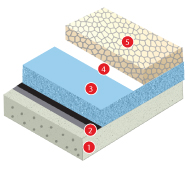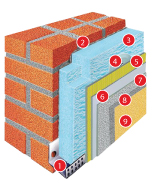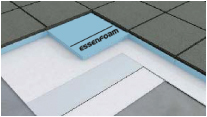![]()
Flat Roof Insulation
In order to obtain maximum performance and long life of insulation, it is most important to choose position of insulation correctly. In conventional systems, insulation is placed under the structural deck layer where deck is always exposed to direct heat or cold. Most affective systems is the inverted roof concept, where water proofing layer is applied first on structural deck and thermal insulation is placed over it. This helps maintain even temperatures inside the buildings and also protect waterproofing layer from mechanical injury and UV radiations.

1. Roof Deck
2. Waterproofing Membrane
3. Thermal Insulation Board
4. Seperation Layer
5. Screedf Flooring
Wall Insulation
Insulation can be applied to interior wall, exterior wall or even as cavity system. However, most affective is the exterior wall insulation due to the fact that it is not interrupted at structural elements like columns, beams and slabs which create thermal bridges if un-insulated.

1. Polymer Profile
2. Primary Fixing Adhesive
3. Thermal Insulation Board
4. Additional Fixing
5. Reinforced Layer
6. Priming Mass
7. Priming Preparations
8. Paint Coating
9. Final
Floor Insulation
It is particularly required where temperatures are extremely high or low through out the year. Soil below the building structure can transit enough heat or cold through un-insulated floors to make interiors uncomfortable.
Insulation boards are an ideal material for this application as it provides:
• High compressive strength
• High resistance to water and moisture penetration
• Low thermal conductivity
